EVGA GeForce GTX 680 Classified Review: Pushing GTX 680 To Its Peak
by Ryan Smith on July 20, 2012 12:00 PM ESTPower, Temperature, & Noise
Wrapping up our look at the stock performance characteristics of the GTX 680 Classified, we have what’s perhaps our most important results section: power, temperature, & noise.
When it comes to custom cards these results can often make or break a card, depending on the niche it’s going for. The GTX 680 Classified is a high performing card, but it’s not a card shooting for performance at any cost, so we expect to find some kind of reasonable balance here.
| GeForce GTX 600 Series Voltages | ||||
| EVGA GTX 680C Boost Load | Ref GTX 680 Boost Load | EVGA GTX 680C Idle | ||
| 1.175v | 1.175v | 0.987v | ||
Note that at its stock settings EVGA must follow NVIDIA’s defaults, so the GTX 680 Classified has the same 1.175v load voltage as the reference GTX 680. This is where binning comes into play, as EVGA needs to identify GK104 GPUs that can reach 1100MHz+ at 1.175v in order to make the GTX 680 Classified a viable product.
| EVGA GTX 680 Classified Average Clockspeed | |||
| Game | Clockspeed | ||
| Crysis: Warhead | 1188MHz | ||
| Metro 2033 | 1211MHz | ||
| DiRT 3 | 1211MHz | ||
| Shogun2 | 1162MHz | ||
| Batman: Arkham City | 1188MHz | ||
| Portal 2 | 1211MHz | ||
| Battlefield 3 | 1188MHz | ||
| Starcraft II | 1188MHz | ||
| Skyrim | 1211MHz | ||
| Civilization V | 1188MHz | ||
Meanwhile, looking at the GTX 680 Classified’s median clockspeed during our benchmarks, we can see that our earlier speculation about the impact of such a high power target was true. The maximum boost bin on our card is 1201MHz (versus 1110MHz for our reference card), and with the exception of Shogun 2, the GTX 680 Classified is almost constantly at 1201MHz or the temperature-induced 1188MHz during our tests. With Shogun 2 that drops down to 1162MHz. With such a high power target the resulting clockspeeds are very consistent for a GTX 680 card.
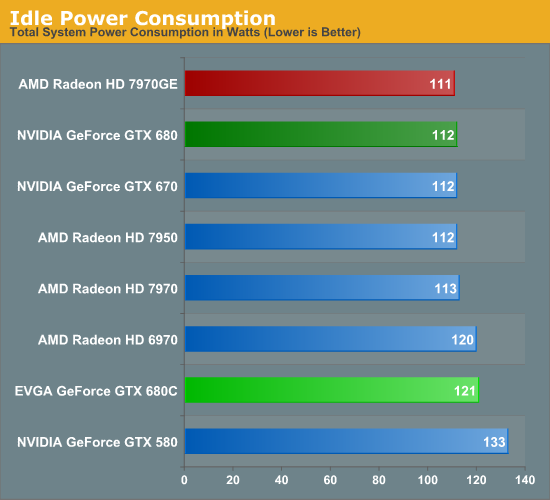
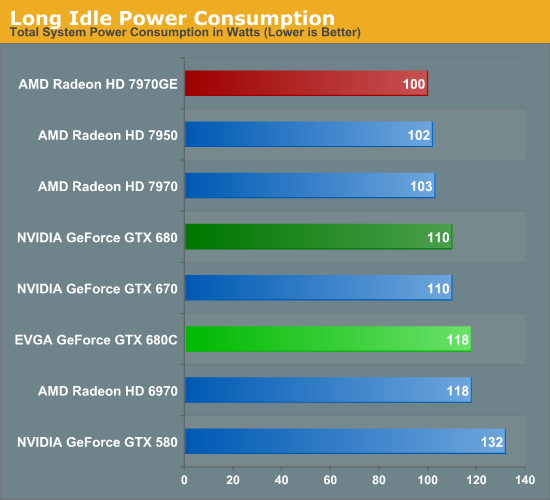
Moving on to power consumption, there are no great surprises here for the GTX 680 Classified when it comes to idle power consumption. With the additional VRM phases and more importantly 8 extra GDDR5 memory chips, idle power consumption has to go up. The impact is that idle power consumption rises by 8-9W, which would push the total idle power consumption of the card up to around 25W. Note however that this is still better than the GTX 580.
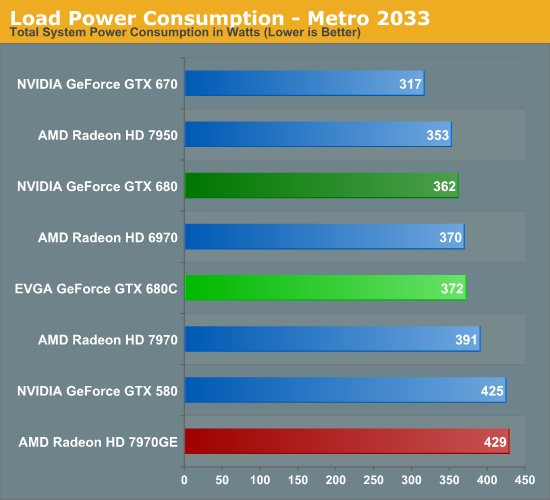
Load power on the other hand looks very good. In fact it’s much better than we were expecting. Despite the additional memory chips and the factory overclock, under Metro power consumption only rises 10W at the wall. This is still less than the7970, let alone the 7970GE.
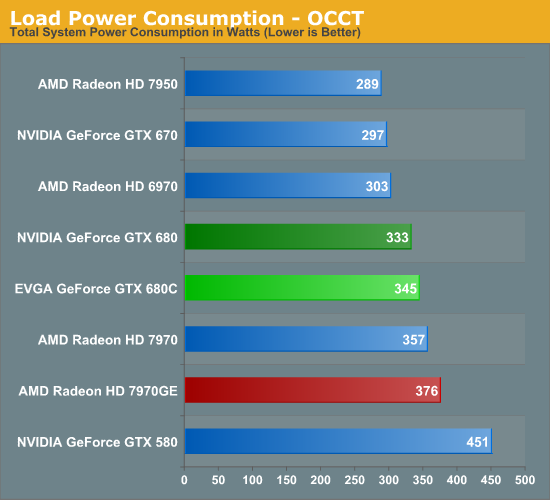
The story with OCCT is much the same. Here we can see that power at the wall increases by all of 12W, which is roughly the remaining difference between the GTX 680 Classified and the 7970. Ultimately the binning process necessary for EVGA to assign GK104 GPUs to their various products has pushed the very best GK104 GPUs into the Classified. The end result is that even at NVIDIA’s standard voltage of 1.175v, the GK104 GPU in our card ends up consuming less power than a more typical GK104 GPU, which allows the GTX 680 Classified to partially offset the higher power consumption of the additional RAM, additional VRM phases, and the factory overclock.
The final result is that the GTX 680 Classified still consumes a bit more power than the reference GTX 680, but not immensely so. Furthermore depending on whether we’re looking at Metro or OCCT, the GTX 680 Classified still draws 30-50W less than the next-nearest competitor, the 7970GE.
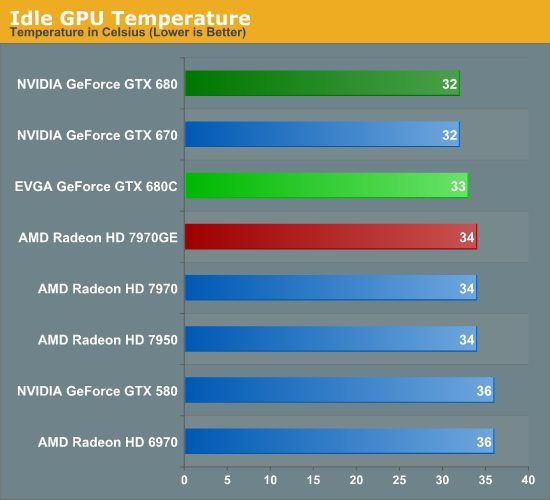
Moving on to temperatures, since EVGA has equipped the GTX 680 Classified with what’s functionally a larger version of the GTX 680’s blower, there are no grand surprises here. The GTX 680 Classified idles at 33C, which so far appears to be typical for these latest iterations of high-performance video cards.

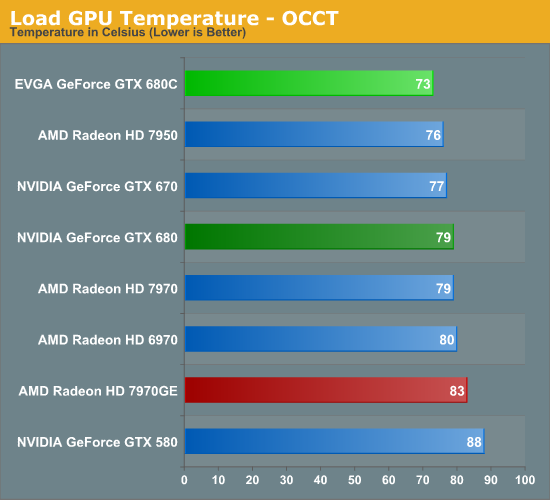
Load GPU temperatures on the other hand are clearly benefitting not only from the larger cooler of the GTX 680 Classified, but also its lower GPU power consumption. With both OCCT and Metro the GTX 680 Classified is 6C cooler than the reference GTX 680. Blowers aren’t known as the most effective coolers, so to reach the low 70s like this is definitely impressive.

Last but not least we have our look at noise levels. Starting with idle noise, the GTX 680 Classified makes no significant tradeoff for its size. Idle noise ends up being a hair higher than the reference GTX 680, but not noticeably so.
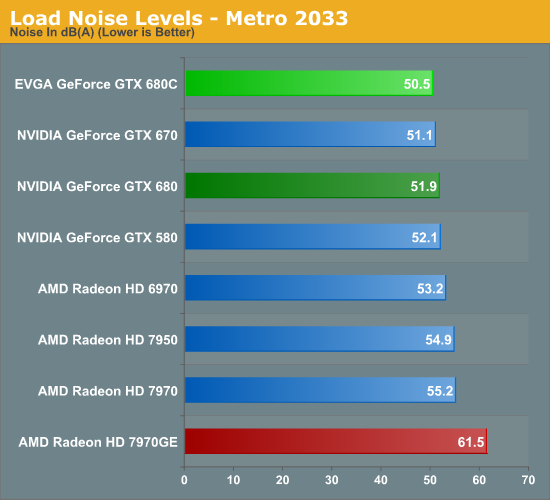
With load noise levels on the other hand we find ourselves once again impressed. The larger cooler and larger fan means that the GTX 680 Classified generates less noise than even the reference GTX 680, which was already a fairly quiet card for its performance level. We had expected EVGA to make some kind of temperature/noise tradeoff here but there’s none to be found. They have managed to lower both at the same time.
Ultimately it’s clear that while EVGA has engineered the GTX 680 Classified for heavy overclocking, they haven’t sacrificed reference performance to get there. When it comes to both temperatures and noise, the GTX 680 Classified is suitably superior to the reference GTX 680. The fact that EVGA did all of this with a blower makes it all the more impressive, since we typically only see gains like these by switching to an open air cooler. Granted these improvements are largely a consequence of the need to overbuild the card for the kind of heavy overclocking it was designed for, but if you do run at stock there are definitely benefits to be realized.










75 Comments
View All Comments
plonk420 - Saturday, July 21, 2012 - link
i'm kinda more interested in 8xMSAA or 4xSSAA...Ryan Smith - Saturday, July 21, 2012 - link
Ahh, okay, I see what you mean.So the short answer is that the memory requirements on Ultra are so high that we wouldn't be able to test most of our previous-generation 1GB cards at 1920 if we used it. I did want to have Ultra in there somewhere so that was the compromise I had to make to balance that with the need for a useful test at 1920.
Though I will agree that it's unorthodox.
RussianSensation - Saturday, July 21, 2012 - link
At the same time that would be pretty useful to see if GTX570/580 run out of VRAM in Shogun with Ultra settings at 1080P. What if GTX660Ti only has 1.5GB of VRAM? We'd want to know if it's already starting to become a bare minimum in games :)CeriseCogburn - Tuesday, July 24, 2012 - link
The 570 and 580 don't run out, but the 5750, 5870, and 6950 1gb and 6970 1gb do. A lot of amd fans have those 1gb cards because as usual, the amd fan is all about scrimping pennies and claiming they have the best anyway. Sad, isn't it.Sadder is the 1920x1200 rez they use here, which allows crap amd cards to lose by less when most people have 1920x1080 where nVidia stomps on amd ever harder, because as usual, amd fan boys are hacking away over pennies and buy the much cheaper and far more common 1920x1080 monitors instead of 1920x1200, saving $50 minimum amd more like $100+.
So, amd loses, all around, again, as usual.
Sabresiberian - Sunday, July 22, 2012 - link
There is no "1200p"Catch-phrases like "720p" and "1080p" refer to television formats; they aren't just the vertical pixel number. 1920x1200 is not a television standard, and the "p" is superfluous.
;)
LtGoonRush - Friday, July 20, 2012 - link
While EVGA's cooler is an improvement over stock, I wonder how a capable card like this would perform if paired with an high performance cooler like the Arctic Accelero Xtreme III. Kepler-based cards drop their boost clocks above 70C to compensate for increased leakage, so it would be interesting to see how fast this card could get while staying below that mark. Even at maximum RPMs the fans would probably be quieter than this one.pandemonium - Saturday, July 21, 2012 - link
I can't understand where the market for this card is. Wait, nevermind. I forgot how many nVidia fanbois there are out there...RussianSensation - Saturday, July 21, 2012 - link
So true. $740 GTX680 with a volt-mod kit vs. $450 HD7970 that overclocks on stock voltage to 1.175V and gives the same performance. NV marketing machine FTW!CeriseCogburn - Tuesday, July 24, 2012 - link
Amd cards never give the same performance as they lack so many features.you can perhaps, if you're lucky, get an fps only equivlanet in a few old games, or a hacked equivalent with crappy IQ that I'm sure you cannot see anyway, and in that case your power/performance is a big fat loser too - we cannot suddenly forget that for just this latest round when it was the most important point ever made for several years just prior now can we...
pffffft !~
ypsylon - Saturday, July 21, 2012 - link
Not with this card. When you buy reference for liquid cooling then you can't go wrong with EVGA. Best cards around. When you buy EVGA Hydrocopper - you can't go wrong. But EVGA Classified are usually only highly overpriced reference designs. Yes there are tweaks here and there, but for max performance [air cooler] out of GTX family most people [including my humble person] go to MSI TwinFrozr3 Lighting/EX.or Asus 3 slot bricks (name escapes me).Lately EVGA sliding with theirs top offerings. SR-X motherboard is cruel joke when compared to ASUS dual CPU creation and now this. Another misfire.
But I think EVGA doesn't care too much. They have devoted customers who buy everything EVGA without thinking...